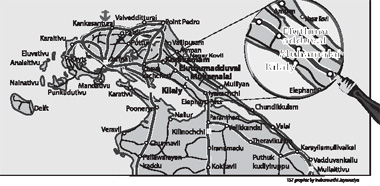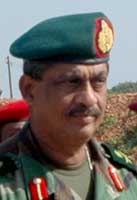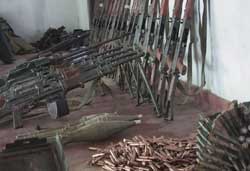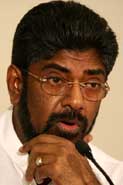
The aftermath of Muhamalai confrontation
Though bizarre, the sequence of events resembled a trailer promoting a film designed to break box office records. However, this was real life drama involving the lives and well-being of the nation's troops fighting a deadly enemy. Media personnel were taken on a conducted tour to the north early this month. The piece de resistance was a trip to the volatile defence lines at Muhamalai, the divide between the Government-held Jaffna peninsula and Tiger guerrilla-dominated Wanni. It is located on the thin isthmus that links mainland Sri Lanka to the peninsula. The defence line here runs from the banks of the Kilali lagoon on the west to the shores of the Indian Ocean on the east. Donning body armour and helmets, media personnel caught a glimpse of the sandy stretches at Muhamalai, sad but true, one of the ugliest killing fields of the current phase of the separatist war. Under President Mahinda Rajapaksa's administration, at least two major battles have been fought in this area. Troops have died or lost their limbs in great sacrifice for their motherland. One was in October 2006 and the other in November last year.
Even without the burst of bullets, the thunder of artillery or mortar shells, any soldier knows that Muhamalai is unfriendly terrain. When there is bright sunshine, the plates of rice and curry they hold in their hand are showered by winds with dusty thin sand. Other times when it rains, the ground is soggy and the menace from the mosquitoes is threatening. With the field visit over, senior Army officers in the peninsula gave the visiting media a detailed briefing of the ground realities. Their accounts made it unequivocally clear that the Army proposed to open a new front. Such a front was only possible by advancing in a southerly direction, across the "no man's land" that lay ahead of guerrilla positions. Other than that, in the rear the troops were holding the Jaffna peninsula. The Kilaly lagoon lay on the west and the seas on the east. Thus, a thrust past Muhamalai towards Elephant Pass (and perhaps later towards Kilinochchi) was the only logical route. Troops have been already engaging the guerrillas on two other fronts in the Wanni-since July 2, last year in the Mannar sector and since January 7, this year north-east of the Weli Oya sector. One of the aims of the military offensive in the Mannar sector was accomplished on Friday when troops entered the areas in and around the sacred Catholic shrine at Madhu. The conducted media tour received wide play. Images on television and printed accounts in newspapers left little doubt that a major military thrust from Muhamalai was in the offing. In fact, some senior Army officers in the north had hinted so. Both English and Sinhala media reported that the Army proposed to open a new front. One could argue that reporting impending military operations is intelligence to the enemy and placed the lives of troops in serious jeopardy. However, here was a case where learned media experts in the military had put together a conducted tour, on their own or at the behest of their superiors who were anxious over media exposure, to convey a message. Hence, most media personnel did not feel there was a need to censor themselves. They also thought that the pundits, who disseminate information on the war, giving statistics and summaries of victories, would know what they were doing. After all, these tours were to highlight the selfless sacrifice of the troops. They were braving all odds. There was no Avurudhu holidays for them. The media tour was for three days beginning April 5. Alas, just 16 days later all hell broke loose at Muhamalai. Troops died and others suffered injuries, some of them seriously. It is no secret that both the defence and security establishments were deeply embarrassed. Official accounts claimed the fighting broke out after Tiger guerrillas mounted an attack on their defended localities. "The Muhamalai FDLs (forward defence lines) came under attack from the Liberation Tigers of Tamil Eelam (LTTE). They attempted to infiltrate into Government controlled areas in the north," Keheliya Rambukwella, Defence Spokesman, told a news conference on Thursday. He said the Army thwarted the attack. He disclosed that 43 soldiers were killed and 33 were missing in action. A further 126 of them, he said, were in hospital and added that "some of them may go back even today." The full text of Mr. Rambukwella's statement, the questions raised and the answers he gave appear in a box story on this page.
On Friday, Army Commander Lt. Gen. Sarath Fonseka met a select group of media personnel at Army Headquarters. He told them 47 soldiers were killed, 33 were missing in action and over 300 were wounded. He claimed that the Army had advanced by some 600 metres ahead of their original defence lines. This, he said, meant the guerrilla defences were now only a 100 metres away. He vowed to carry on the military campaign against Tiger guerrillas. Even if one were to, for purposes of argument, accept that the official versions are factually correct - that the guerrillas launched a surprise attack on the Army's Muhamalai defences - it raises a number of important questions. Firstly, such an attack had taken place only 16 days after the media, during a conducted tour, was shown and told by senior Army officers of the formidable defensive positions. How did such an attack, a serious lapse take place leading to the deaths of even 47 soldiers as claimed? How did the strong defences become so vulnerable for the guerrillas to cause so much damage? Secondly, did the guerrillas take a cue from the outcome of the conducted tour (the media reportage) to launch an attack, as claimed? If indeed this is so, did the media pundits who put together the conducted tour do irreparable damage to national security that led to the deaths and injuries to soldiers? Was this attack in any way linked to intelligence reports that the guerrillas had re-called strength from the Mannar sector and deployed them in their Muhamalai defences just days before the incident? This is besides a strength of some 800 trained cadres, which intelligence reports said, had been poured into Muhamalai weeks earlier? It is therefore clear that claims that the guerrillas mounted an attack raise more questions than answers.This is particularly in the light of troop positions being declared impregnable and plans to open a new front announced to the media. On the other hand, The Sunday Times has learned from officers and men in the north as well as seniors at Army Headquarters that the Army launched an offensive operation. Here is an account constructed from what they said strictly on grounds of anonymity. The Army's 53 and 55 Divisions broke out of their defences shortly after 2.30 a.m. Wednesday. One flank led by Brigadier Susantha Sooriyabandara had advanced from near the A-9 highway side where the now closed down Muhamalai entry-exit point is located. Another flank led by Brigadier Kamal Gunaratne moved in a southerly direction from the general area across the lagoon west of Nagerkovil. It was an advance from all along the defence lines spanning some eight kilometres. Taking part in the operation were some 5,000 troops though only a lesser number played a fighting role. Others were in supporting roles. The guerrillas had feigned withdrawal by exiting from their first line of defence. Thereafter, the troops had advanced towards that area when guerrillas sprung a surprise. Heavy fighting broke out. Troops had later returned to their original positions. The guerrillas had fired small arms, artillery and mortars. There were also unconfirmed reports that they used two improvised shells, one named Samathanam (Peace) and the other Raghavan. The first shell, reports said, contained traces of phosphorous but independent confirmation of these reports were not possible. If indeed these reports are correct, the guerrillas have been using a chemical weapon. The Sunday Times learned that more than one hundred troops were killed in the incident. The LTTE had handed over, through the International Committee of the Red Cross (ICRC), the bodies of 28 soldiers. A further 348 or more were wounded. On Wednesday, 121 soldiers were admitted to Sri Jayawardenapura Hospital, Kotte, 10 to the Eye Hospital, Colombo, 35 to the National Hospital, Colombo, 40 to the Army Hospital, Colombo and 128 to the Army Hospital in Palaly. There were reports from Kilinochchi that an unknown number of soldiers were taken as prisoners. However, Army sources are unable to confirm this.
The LTTE remained silent over their casualties. However, Defence Spokesman Keheliya Rambukwella said 100 guerrillas have been killed. Other claims by Government channels placed the guerrilla death toll at 300. More details about the incident and the consequent Government responses cannot be divulged due to personal constraints. "Government bars photographers, censors news from war front" 25 April 2008, Colombo, Sri Lanka: Government officials barred photographers from entering hospitals where soldiers injured in battle are being treated, four photo journalists told the Free Media Movement (FMM) yesterday. Hitherto, photographers have had no problems in entering hospitals to report on the casualties of war. It is highly likely that these measures have been taken after heavy losses (numbering in the hundreds) faced by the Sri Lankan Army earlier this week after fighting intensified in the North. "All government appointed military spokespersons give watered down figures of war casualties and mainstream media are compelled to report these official statistics. Only some foreign wire services and few news websites operating from Colombo reported the battle front casualties independent of government press releases. According to government military statements that have been published by media, the Army has killed more than 3,000 LTTE fighters in 2008. 3,000 was the figure given by Army Commander as the strength of the LTTE military six months ago. In Sri Lanka today the saying that first casualty of war is truth is being proved almost every day. "The FMM believes that the right of the public to know information and news related to the ongoing war is severely undermined by the restrictions placed on journalists. Both the LTTE and the Government do not allow independent media to cover the war in a manner that accurately reports, amongst other things, the numbers dead and injured. The FMM has demanded both sides to allow media to cover the war independently for nearly 15 years. "We urge the government and the LTTE to respect the right to information. War propaganda is not a substitute for accurate, impartial and responsible journalism that can only be ensured by supporting and strengthening media freedom and the freedom of expression in Sri Lanka." Pro-LTTE web sites gave detailed coverage to what they described as how the guerrillas foiled an attack by the Army before crack of dawn on Wednesday. Several photographs, some containing gory accounts of dead troops, others showing piles of weapons reportedly seized and crowds looking at bodies were prominently displayed. The news of the incident reached Government leaders when the National Security Council was in session. It is here that President Rajapaksa heard the initial accounts. The Sunday Times has learned that there was neither naval nor air support when the operation got under way. The inclusion of naval and air support in a major operation, even to a lay mind it is clear, is of much significance. So are contingency plans for evacuation of the wounded. The Commanders of the Navy and the Air Force were unaware of the operation. So was the Chief of Defence Staff (CDS). Only after the offensive had ended, however, the Air Force had carried out sorties. One was on a guerrilla artillery gun position. In the light of this a number of questions beg answer. What led to the poor planning of such an offensive operation without inputs from the Navy and the Air Force? Where does accountability for this for this serious debacle rest and was approval of the defence hierarchy obtained? These are just a few of the multitude of questions that arise. These questions are being raised in the national interest. Poorly planned offensives in the past have shown how they have imperilled life and limb of troops and demoralised a nation. On Friday, Army Headquarters shifted Brigadier Samantha Sooriyabandara as officiating General Officer Commanding the 53 Division. He is tipped to go as Defence Attache in the Sri Lanka Embassy in Washington D.C. This position was taken over by Brig. Kamal Gunaratne. Taking over as officiating GOC 55 Division is Brigadier Prassanna Silva. The latter, together with many officers including then Eastern Commander Maj. Gen. Parakrama Pannipitiya, were among those who successfully conducted offensive operations against Tiger guerrillas in the East. This paved the way for the re-capture of the East. Brig. Silva was until this week attached to the Army's garrison at Kosgama. Amidst the confusion created by conflicting accounts over Wednesday's incidents at Muhamalai, the guerrillas exploded a bomb inside a bus at Piliyandala on Friday evening. At least 26 civilians were killed and more than 65 wounded. As reported last week, the guerrillas have opened new fronts in the Central Province prompting the Ministry of Defence to appoint Maj. Gen. Lawrence Fernando a senior Army officer, as Overall Operations Commander. This showed a widening of guerrilla activity. On Thursday, Defence Spokesman Rambukwella declared that the Government's military campaign was "on track" and they hope to weaken the guerrillas by the end of this year. The remarks indeed are assuring. Unlike at news conferences, such an achievement should come in the battlefields if the guerrillas are to be defeated. That is the challenge for the people of Sri Lanka and the troops who are fighting so valiantly. Until that is achieved, the guerrillas will remain a potent threat. No LTTE by the end of the year: Govt. Defence Spokesman Keheliya Rambukwella made the following remarks over the Muhamalai incidents at a news conference on Thursday:
"It is important to be aware about the real situation at Muhamalai. There are various reports in the media. We want to give this information with some responsibility. Like during the incident in Anuradhapura (attack on the air base) I want to emphasize that the information is based on reports available up to now. I repeat that it is up to this time. "Day before night, Muhamali FDLs came under attack from the LTTE. They attempted to infiltrate into Government controlled areas in Jaffna. They had been fully prepared. The Army thwarted the attack. They repulsed the attack. 43 soldiers were killed and 33 soldiers are missing in action. Earlier it was 38 and five of them had come back. As at now 33 are missing. Nearly 160 are injured and of them 22 have returned to the front. 126 are in hospital and some of them may go back even today. "According to the information over 100 LTTE cadres have been killed and 81 of them could be named. 196 of them have been injured. The army was able to go to the LTTE FDL - that is about 500 metres. They have been pushed back to the second defence line. The first line is under the control of the Army. "Regarding Muhamalai, I have to reiterate as of now. The LTTE in a large strength, possibly with the maximum strength they were trying to infiltrate the FDL of the Army. The Army has been able to repulse the attack and move forward about 500 metres and the Army is confident and has established lines where the LTTE FDL was. In this confrontation 43 army personnel have died, 33 are missing. Earlier, 38 soldiers were missing and, of them five returned." Q: When You say 81 Tigers are confirmed dead, what did you mean? A: That is the information the Army has received. Q: Of the 43 soldiers killed, how many bodies have been recovered. A: All 43 bodies. Q: The Tigers say they got 30 bodies. A: That is why we say 33 are missing. Q:How do you expect most of them to come back A: Earlier we had 38 missing and five of them have come back . So we have counted that 33 are missing. Q: On the defence.lk website they first said that this was a military offensive. You are now saying that they retaliated after an attack. Which one is correct? Brig: Udaya Nanayakkara, Military Spokesman: The MCNS said it was a retaliatory attack Q: So the Ministry of Defence got it wrong. Brig: They have said it wrong Q: How many LTTE bodies have you got? Brig: Six LTTE bodies Q: If you have been able to reach the LTTE FDL, how have the Tigers been able to take pictures of the dead soldiers in a trench? Brig: This is an attack we have carried out forward of their line of defence. We are holding on to that line. Even some troops have gone forward into their territory. Those soldiers who have gone forward are those missing. Those photographs may be those who have gone missing. Q: Some of the reports say this was a military disaster Keheliya Rambukwella: Certainly not. Certainly not. Disasters have happened when 1500 people were killed in Elephant pass. Q: Is it a set back A: We have moved forward, so it is not a setback. If you move backwards you can call it setback. Q: Is it that when the troops moved forward the LTTE had registered their artillery and mortar positions to fire at the soldiers. This was an ambush essentially. It sounds like that troops fell into a trap of the LTTE. A: One could interpret it that way. When you engage in a battle of this nature, a 30-year-old battle, we have debacles. In between we have fierce battles, and that is part of the routine. As far as the Army is concerned they are confident that they have moved forward. They have established themselves. That is the target. They have gone 500 metres. Q: Will there be more offensives in Muhamalai? A: You cannot say, but the liberation operations will continue. Q: Regarding the elimination of the LTTE, at one point you told April and now you have said the end of the year. A: Subsequently it was told end of the year. That stands. Q: You mean end of the year there will be no LTTE? A: That is what the Army Commander had said. Plans are set out to eliminate the LTTE by the end of the year. Q: So the plan is to eliminate terrorism by the end of the year? A: That was repetition of what the Army Commander had said. Q: Is that the official stand of the govt? A: It is the defence authorities. Q: The Government hopes to end terrorism by the end of the year? A: I am repeating that the Army has said that its plans are to end terrorism. Q: What we are asking is about Government plans to end terrorism by the end of the year. A: The Commander is part of the govt. The Government does not take a different stand. Q: So the Army Commander and the Government still say that the LTTE will be beaten by the end of the year. A: I have told you very clearly, the Government gets information from the defence authorities. The defence authorities have said very clearly that they have plans to end terrorism by the end of the year. The Government has accepted that. Q: About the strength of the LTTE, how does their strength grow? A: It could be about 50 per cent of their strength would have been in the FDL. The UN has confirmed that the Child recruitment is going on. Q: Will there be any inquiry held? A: Those are routine things. The Army will look into them. Q: What is the significance of this operation? A: You have to ask the LTTE. Q: From the military point of view how do you view the recapture. A: We have advanced. |
|
||||||
|| Front
Page | News | Editorial | Columns | Sports | Plus | Financial
Times | International | Mirror | TV
Times | Funday
Times || |
| |
Reproduction of articles permitted when used without any alterations to contents and a link to the source page.
|
© Copyright
2008 | Wijeya
Newspapers Ltd.Colombo. Sri Lanka. All Rights Reserved. |



